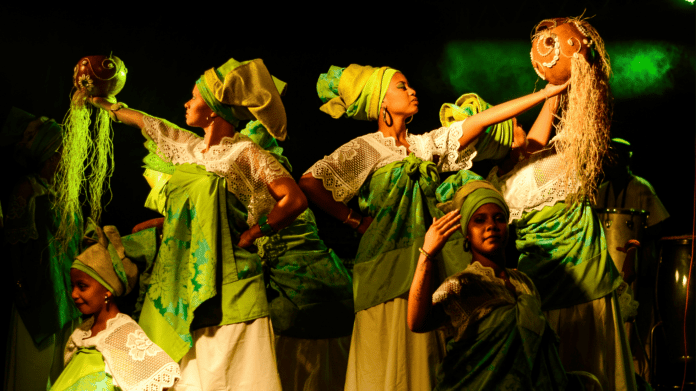Nigeria’s cultural diversity is a tapestry of rich traditions, with over 250 ethnic groups, each contributing its own unique art forms and customs. Among these treasures, traditional dance stands out as a vibrant expression of history, spirituality, and identity. Far from being mere entertainment, these dances serve as powerful storytelling tools, celebrating the values, beliefs, and heritage of Nigeria’s people. Whether performed during festivals, ceremonies, or communal gatherings, these captivating movements connect past generations to the present, offering an unforgettable glimpse into the heart of Nigerian culture.
1. Atilogwu Dance (Igbo Culture)
The Atilogwu dance is a high-energy, acrobatic performance native to the Igbo people of southeastern Nigeria. It is characterized by its vibrant costumes, rapid footwork, and synchronized movements that require immense skill and stamina. The word Atilogwu translates to “is this magic?” a fitting name given the dancers’ gravity-defying leaps and somersaults.
Significance:
- Often performed during festivals, weddings, and cultural celebrations.
- It is a symbol of joy and communal pride among the Igbo.
2. Bata Dance (Yoruba Culture)
The Bata dance originates from the Yoruba people of southwestern Nigeria and is closely associated with the worship of Sango, the god of thunder in Yoruba mythology. The dance features intricate footwork, dramatic body movements, and a rhythmic interaction with the talking drum (Bata drum), which is also central to the performance.
Significance:
- Performed in traditional religious ceremonies and festivals.
- Represents reverence for Sango and the Yoruba pantheon of gods.
3. Sharo Dance (Fulani Culture)
The Sharo dance is an integral part of the Fulani tradition, often performed during the Sharo festival, a coming-of-age ceremony for young men. This dance, accompanied by songs and rhythmic drumming, showcases the courage and endurance of participants.
Significance:
- Marks the transition from boyhood to manhood.
- A spectacle of strength, grace, and cultural pride.
4. Egungun Dance (Yoruba Culture)
The Egungun dance is a spiritual performance by masquerades representing ancestral spirits in Yoruba culture. The performers wear elaborate costumes and masks as they glide and twirl to the rhythm of drums and chants, creating an atmosphere of reverence and mystery.
Significance:
- Celebrates and honors ancestors.
- Central to traditional religious festivals like the Egungun Festival.
5. Swange Dance (Tiv Culture)
The Swange dance is a signature performance of the Tiv people in central Nigeria. Known for its fluid movements and sensual rhythm, Swange is accompanied by traditional music that includes flutes, drums, and xylophones.
Significance:
- Performed during festivals and joyous occasions.
- Expresses the beauty and harmony of Tiv culture.
Related Content: Top Cultural Festivals in Nigeria You Can’t Miss
6. Koroso Dance (Hausa Culture)
The Koroso dance is a vibrant and colorful performance from the Hausa people of northern Nigeria. Dancers wear beaded costumes and engage in energetic movements synchronized with the beats of traditional instruments like the kalangu (talking drum) and kakaki (long trumpet).
Significance:
- Performed at weddings, festivals, and official ceremonies.
- Symbolizes joy, unity, and cultural pride.
7. Eyo Festival Dance (Lagos Island)
The Eyo festival, unique to Lagos Island, is one of Nigeria’s most iconic cultural events. Performers, known as Eyo masquerades, dress in white flowing robes with hats and masks, moving gracefully in a procession accompanied by music and chants.
Significance:
- Celebrates Lagos’s cultural heritage.
- Held in honor of deceased noble figures or to usher in new leaders.
8. Gwari Dance (Gwari/Bwari Culture)
The Gwari dance comes from the Gwari (or Bwari) people of central Nigeria. It is marked by rhythmic stomping and elegant arm movements, often performed in a circular formation. The dance is accompanied by traditional drums and flutes.
Significance:
- Performed during planting and harvest seasons.
- Symbolizes harmony between humans and the land.
9. Nkwa Umuagbogho Dance (Igbo Culture)
The Nkwa Umuagbogho dance is a performance by young maidens in Igbo communities, characterized by graceful movements and a display of feminine beauty and elegance. The dancers wear traditional wrappers and beads while performing synchronized steps to drum beats and traditional songs.
Significance:
- Celebrates the beauty and virtue of young women.
- Performed during festivals and marriage ceremonies.
10. Ekombi Dance (Efik Culture)
The Ekombi dance is a traditional performance of the Efik people of Cross River State. It features slow, elegant movements that mimic the waves of the ocean. Female dancers wear beautiful attire made of coral beads and intricate fabrics.
Significance:
- Performed during weddings, coronations, and cultural celebrations.
- Represents purity, elegance, and the cultural heritage of the Efik.
Nigeria’s traditional dances are a window into the soul of its diverse cultures. These performances are more than just artistic expressions they are vital links to the country’s history, spirituality, and communal identity. Watching these dances is not only a visual delight but also a deep cultural experience that provides insight into the richness of Nigerian traditions.
Whether you’re attending a grand festival in Lagos, a village celebration in the southeast, or a cultural event in the north, you’re bound to encounter these mesmerizing performances. If you ever visit Nigeria, make it a point to witness these dances they are a feast for the eyes and a celebration of the human spirit.


